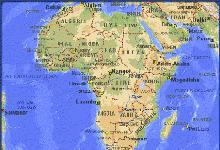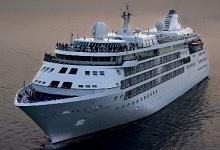Recently Viewed Cruises
- Wind, Voyage 2337 ex Cape Town ReturnAdd to favourites
- Wind, Voyage 2336 ex Las Palmas to Cape TownAdd to favourites
- Saga Sapphire, Africa & Solar Eclipse ex Southampton ReturnAdd to favourites
- Silver Explorer, Voyage 7308 ex Accra to DakarAdd to favourites
- Whisper, Voyage 4306 ex Port Louis to Cape TownAdd to favourites
- Royal Caribbean International raises the bar
- Classy Astor fills gap in market
- Oceanic Discoverer
- Ab Fab Oosterdam
- Catch up on Cruising: Latest cruise news in bite size
- Frequently Asked Questions
-
Wind, Voyage 2337 ex Cape Town Return
Nights 14 Ship Silver Wind Star Rating 
Departs Cape Town, South Africa Sailing 2013: 21 Dec Ports of Call Cape Town, Walvis Bay, Port Elizabeth South Africa, East London, Durban, Richards Bay, Mossel Bay Select a sailing date for approximate pricing.
Prices are per person, twin share. When booking please check current cruise fare and inclusions. Prices are indicative only, subject to currency fluctuations and may change at any time without notice.
14 Night Cruise sailing from Cape Town roundtrip aboard Silver Wind.
Silver Wind, launched in 1995, was the second ship introduced by Silversea. Much like its sister ship, Silver Cloud, the Wind is a shining example of intimate Italian cruising. Fewer guests, combined with more space and Silversea's signature six-star personalised service make for the ultimate sailing experience. This elite vessel is as a grand hotel, as gracious as a long-time friends' home. Each all ocean-view suite provides a sumptuous retreat. Each public space is intimate yet inviting. It's a warm feeling of home upon the seas of the earth.
Aboard Silver Wind you will find a most accommodating place to view our world. Whether it's delicious onboard diversions, world-class cuisine, memorable dining venues or staying connected from anywhere, Silversea's impeccable standards apply to every detail of your voyage.
Highlights of this cruise:
Cape Town
Sheltered beneath the familiar shape of Table Mountain, the historic city of Cape Town is instantly recognizable, and few cities in the world possess its beauty and style. A stroll through the lovely city center reveals Cape Town's three centuries as the sea link between Europe and the East. Elegant Cape Dutch buildings, characterized by big whitewashed gables, often a thatch roof, and shuttered windows, abut imposing monuments to Britain's imperial legacy. In the Bo-Kaap neighborhood the call to prayer echoes from minarets while the sweet tang of Malay curry wafts through the cobbled streets. And everywhere, whether you're eating outdoors at one of the country's best restaurants or sipping wine atop Table Mountain, you sense-correctly-that this is South Africa's most urbane, civilized city.
Walvis Bay
Formerly a whaling station, Walvis Bay has become the principal port of entry into Namibia. In 1795, while occupied by the British, Walvis Bay was turned into a naval base in order to monitor and intimidate the empire's European rivals during the so-called "scramble for Africa". When Namibia gained independence in 1990, Walvis Bay and the surrounding enclave remained part of South Africa until February 28, 1994. On this date, the enclave was transferred to Namibian control, ending a long disputed claim between the two countries.
The town is built for the harbour, with numbered streets forming an unexciting, but easily navigable grid around it. The city centre can be covered on foot. Of special note are the municipal buildings, decorated with attractive wood carvings from Namibia's Kavango region. Exhibits at the local museum illustrate the history of the town and the indigenous Topnaar people. The lagoon on the outskirts of Walvis Bay is home to a bird sanctuary. Flocks of flamingos and pelicans feed here in the nutrient-rich water. The lagoon also supports an important salt industry.
The resort town of Swakopmund lies 24 miles (38 km) north of Walvis Bay. It was under German domination until 1915. With Walvis Bay under British control, the German authorities tried to develop their own interests by establishing Swakopmund as a port, but without much success. When German rule was surrendered to South Africa, all trading returned to Walvis Bay. Before independence, Afrikaans, English and German were the official languages. Following independence, English became the official language, with Bantu and Khoi-San the main ethnic language groups.
Walvis Bay is a good starting point for excursions into the desert and dune regions, offering visions of unspoiled landscapes, compelling beauty and a feeling of unconfined space.
Port Elizabeth
Port Elizabeth, or PE, may not have the range of attractions found in Cape Town or on the Garden Route, but there are some beautiful beaches (although beach conditions are best here early in the day in summer) and some wonderfully preserved historic buildings in the older part of the city, called Central. A large part of the town's charm lies in its small size and quiet environment, but PE is not a total sleepy hollow. The Boardwalk complex near the beach has restaurants, cafes, theater, and casino, and Parliament Street in Central, which has recently been pedestrianized, has a vibrant restaurant and nightlife scene. PE is a good base for exploring some other fantastic destinations, both wild and cultural, including Addo Elephant National Park and Shamwari Game Reserve.
Richards Bay
Founded in the 1880s, during the Anglo-Zulu colonial wars, Richards Bay was named after British Rear Admiral Sir Frederick William Richards, who landed a naval force here. An early claim to fame came in 1891, when colonial adventurer John Dunn killed a 22-foot crocodile in the estuary-still one of the largest ever documented-but the town remained a backwater with a population of less than 200 people until as recently as 1968. Today, Richards Bay is the major port in the region and is adjacent to significant mineral deposits, which have contributed to the town's massive growth. Visitors may be more interested in what awaits beyond in the hinterland. Richards Bay is the gateway to the land of the Zulu, one of Africa's most fascinating tribal peoples, and from here you have easy access to some of the world's finest wildlife game parks, including the Hluhluwe-Umfolozi Game Reserve, which protects the highest concentration of white rhino left in Africa.
Cape Town
Sheltered beneath the familiar shape of Table Mountain, the historic city of Cape Town is instantly recognizable, and few cities in the world possess its beauty and style. A stroll through the lovely city center reveals Cape Town's three centuries as the sea link between Europe and the East. Elegant Cape Dutch buildings, characterized by big whitewashed gables, often a thatch roof, and shuttered windows, abut imposing monuments to Britain's imperial legacy. In the Bo-Kaap neighborhood the call to prayer echoes from minarets while the sweet tang of Malay curry wafts through the cobbled streets. And everywhere, whether you're eating outdoors at one of the country's best restaurants or sipping wine atop Table Mountain, you sense-correctly-that this is South Africa's most urbane, civilized city.







